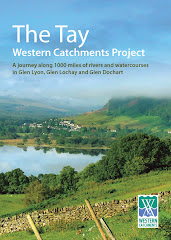We are using this incredible piece of footage to launch our TWCP blogspot. Nelly (Neil Wardman) is pictured having his lunch by the side of Loch Dochart, when, after hearing some noise in the water, these two young otters suddenly appeared, ran up to Nelly, played around for 10-15 seconds, and then disappeared. Our other surveyor on the day, Richard Turner (Biscuit) shot this video on his mobile phone. Nelly is trying not to move in case he scares the otters away, and hence justs sits there smoking his cigarette.
These are real, wild, Scottish otters. Biscuit and Nelly where surveying the river and loch by canoe, and were resting in an area not usually visited by humans. Maybe this is why the otters seem so relaxed.
We will be updating this site throughout the summer with all interesting video footage that we take, and with two people out every day, we hope to establish a huge archive of material for future reference and enjoyment. We hope that you enjoy this site.
Please have your speakers on for this video, and you will hear the otters squeaking to each other.
For more background information on our survey work, please link to
Tay Western Catchments Project.



















































